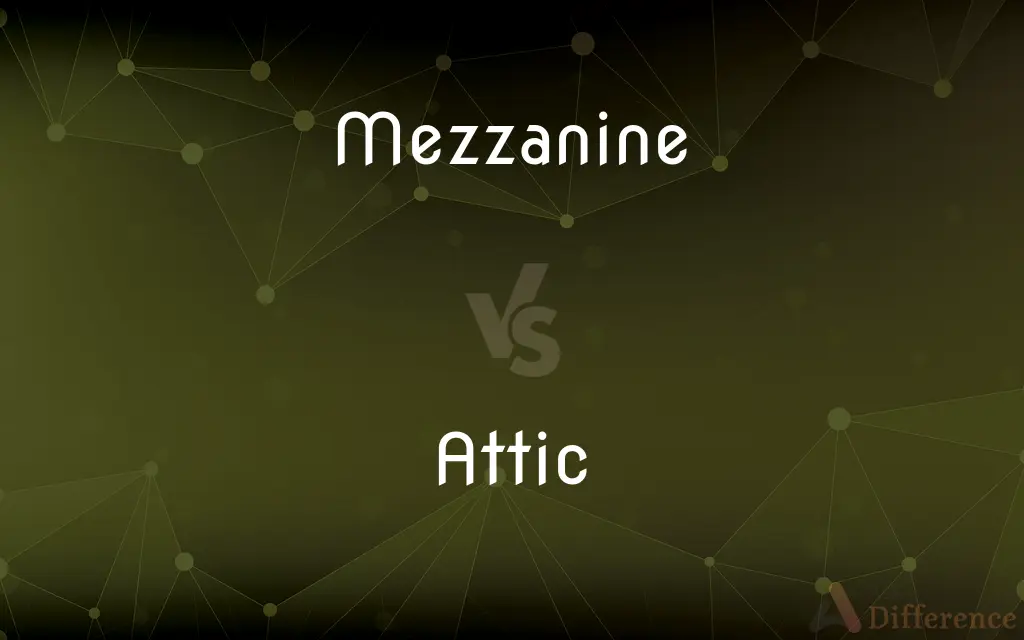Mezzanine vs. Attic — What's the Difference?
By Tayyaba Rehman — Updated on November 6, 2023
Mezzanine is an intermediate floor between main floors of a building, often low-ceilinged or open-plan; an attic is a space under the roof, used for storage or habitation.

Difference Between Mezzanine and Attic
Table of Contents
ADVERTISEMENT
Key Differences
In a building, a mezzanine is a partial floor that is typically located between the ground and first full floor, often projecting in the form of a balcony. It's an architectural feature that can serve various purposes, such as providing additional floor space or serving as a viewing platform. On the other hand, an attic is found at the top of a building, directly under the roof. It's usually a closed space that might be used for storage, as living quarters, or remain unused. The mezzanine is often part of a larger open space, allowing for interaction with the floors it connects, while the attic is separate and distinct, a world unto itself beneath the rafters.
Mezzanines can be found in commercial buildings like malls, where they add extra retail space without the need for full new floors. They can also be a feature in residential homes, adding a lofted area that overlooks the living space below. Attics, conversely, are more commonly associated with residential homes, providing a secluded area that can be converted into a quiet study, bedroom, or maintained as a place to keep seldom-used items out of sight.
The design of a mezzanine is such that it is often open to the floor below, either partially or fully, providing a sense of spaciousness. They may have limited accessibility, like a staircase or a lift. Attics, in contrast, are typically accessed via a dedicated staircase or pull-down ladder and are enclosed, which can make them feel more isolated from the rest of the building.
The utility of a mezzanine can be diverse, ranging from additional seating in theaters to storage spaces in warehouses. They can also enhance the aesthetic appeal of a space, giving a modern and dynamic feel to interiors. Attics are less about aesthetics and more about functionality, although when finished, they can add significant living space and value to a home. They are also often the location for insulation materials that help in regulating the building's temperature.
Comparison Chart
Location in Building
Between the main floors, not on top
At the very top of a building
ADVERTISEMENT
Accessibility
Through the main building area
Often via a separate ladder or staircase
Use of Space
Commercial or aesthetic space, occasionally residential
Primarily storage, sometimes converted into living space
Enclosure
Open to the area below it
Enclosed and separate from other rooms
Ceiling Height
Typically lower than regular floors
Sloped or varied, following the roofline
Compare with Definitions
Mezzanine
A partial story that serves as a floor in a building's high-ceilinged room.
The spacious mezzanine of the art gallery was dedicated to contemporary sculpture.
Attic
A space or room just below the roof of a building.
In the attic, we found boxes of old family photos and heirlooms.
Mezzanine
A low-ceilinged story between two main stories of a building.
The office's mezzanine was transformed into a lounge area for employees.
Attic
A room or space, often unfinished, directly under the roof.
The attic was filled with forgotten antiques and vintage furniture.
Mezzanine
An intermediate floor in a building, open to the floor below.
The mezzanine in the library offers a quiet reading space above the main floor bustle.
Attic
The uppermost space of a building, often used for storage or habitation.
They converted the dusty attic into a cozy guest bedroom.
Mezzanine
A platform or floor constructed in an industrial space to increase storage capacity.
The warehouse installed a mezzanine to accommodate the excess inventory.
Attic
In architecture, the space within the pitched roof of a building.
The attic's triangular shape made it an interesting challenge to design.
Mezzanine
A mezzanine (; or in Italian, a mezzanino) is, strictly speaking, an intermediate floor in a building which is partly open to the double-height ceilinged floor below, or which does not extend over the whole floorspace of the building. However, the term is often used loosely for the floor above the ground floor, especially where a very high original ground floor has been split horizontally into two floors.
Attic
A loft or space used for domestic storage or living quarters.
The children loved playing in the attic on rainy days, imagining it was a pirate ship.
Mezzanine
A partial story between two main stories of a building.
Attic
An attic (sometimes referred to as a loft) is a space found directly below the pitched roof of a house or other building; an attic may also be called a sky parlor or a garret. Because attics fill the space between the ceiling of the top floor of a building and the slanted roof, they are known for being awkwardly shaped spaces with exposed rafters and difficult-to-reach corners.
Mezzanine
The lowest balcony in a theater or the first few rows of that balcony.
Attic
A story or room directly below the roof of a building, especially a house.
Mezzanine
Of or relating to securities granting a claim on interest or assets that is subordinate to that of secured and senior debt but above that of equity.
Attic
A low wall or story above the cornice of a classical façade.
Mezzanine
(architectural element)
Attic
The ancient Greek dialect of Attica, in which the bulk of classical Greek literature is written.
Mezzanine
An intermediate floor or storey in between the main floors of a building; specifically, one that is directly above the ground floor which does not extend over the whole floorspace of the building, and so resembles a large balcony overlooking the ground floor; an entresol.
On our way to the top floor, we stopped at the mezzanine.
Attic
Of, relating to, or characteristic of ancient Attica, Athens, or the Athenians.
Mezzanine
(by extension) An apartment, room, etc., on such an intermediate floor.
Attic
Characterized by purity, simplicity, and elegant wit
Attic prose.
Mezzanine
The lowest balcony in an auditorium, cinema, theatre, etc.; the dress circle.
Attic
The space, often unfinished and with sloped walls, directly below the roof in the uppermost part of a house or other building, generally used for storage or habitation.
We went up to the attic to look for the boxes containing our childhood keepsakes.
Mezzanine
(obsolete)
Attic
(slang) A person's head or brain.
Mezzanine
A floor under the stage, from which contrivances such as traps are worked.
Attic
Of or pertaining to Attica, in Greece, or to Athens, its principal city; marked by such qualities as were characteristic of the Athenians; classical; refined.
Mezzanine
Characteristic of or relating to high-interest loans which have no collateral, and are regarded as intermediate in nature, ranking above equity but below secured loans.
Attic
A low story above the main order or orders of a facade, in the classical styles; - a term introduced in the 17th century. Hence:
Mezzanine
(engineering) Fulfilling an intermediate or secondary function.
To make interconnections easier, we added a mezzanine PCB.
Attic
An Athenian; an Athenian author.
Mezzanine
(transitive) To fit (a building or other place) with a mezzanine floor.
Attic
Floor consisting of open space at the top of a house just below roof; often used for storage
Mezzanine
Same as Entresol.
Attic
The dialect of Ancient Greek spoken and written in Attica and Athens
Mezzanine
A flooring laid over a floor to bring it up to some height or level.
Attic
Informal terms for a human head
Mezzanine
A floor under the stage, from which various contrivances, as traps, are worked.
Attic
(architecture) a low wall at the top of the entablature; hides the roof
Mezzanine
The lowest balcony in a theater, or the forward part of the first balcony.
Attic
Of or relating to Attica or its inhabitants or to the dialect spoken in Athens in classical times;
Attic Greek
Mezzanine
First or lowest balcony
Mezzanine
Intermediate floor just above the ground floor
Common Curiosities
What is a mezzanine?
A mezzanine is an intermediate level between the main floors of a building, partially open to the double-height ceiling space below.
Do mezzanines need special building permits?
The need for building permits for mezzanines varies by location and the extent of construction; always check local regulations.
Can an attic be converted into a living space?
Yes, attics can often be converted into living spaces, provided they meet building regulations for headroom, access, and safety.
Is a mezzanine considered a full floor?
No, a mezzanine is not considered a full floor; it is a partial or intermediate floor within an existing story.
Do all houses have attics?
Not all houses have attics; it depends on the design of the house and the shape of the roof.
How is an attic different from a mezzanine?
An attic is a space under the roof of a house, typically used for storage or additional living space, while a mezzanine is a middle floor open to the floor below.
What is the primary function of an attic?
The primary function of an attic is usually for storage, but it can also be converted into living space.
How does the presence of an attic affect home heating and cooling?
An attic can have a significant impact on home heating and cooling efficiency, especially if it is well-insulated and ventilated.
Can a mezzanine add value to a property?
A well-designed mezzanine can add aesthetic and functional value to a property, particularly in commercial spaces.
Are attics insulated?
Yes, attics are typically insulated to reduce heat loss and gain, which helps regulate the temperature in the home.
Is it expensive to build a mezzanine?
The cost of building a mezzanine can vary greatly depending on size, materials, and design complexity.
Can an attic be finished or remodeled?
Yes, attics can be finished or remodeled to become more functional spaces, subject to building codes and structural limitations.
How do you access a mezzanine?
Access to a mezzanine is typically through stairs or a lift within the building.
Are there different types of mezzanines?
Yes, there are different types of mezzanines, including free-standing, rack-supported, and shelf-supported, each serving different purposes.
What materials are used to build a mezzanine?
Mezzanines can be built using a variety of materials, including steel, wood, and concrete, depending on the intended use and design.
Share Your Discovery

Previous Comparison
Deflection vs. Displacement
Next Comparison
Like vs. FollowAuthor Spotlight
Written by
Tayyaba RehmanTayyaba Rehman is a distinguished writer, currently serving as a primary contributor to askdifference.com. As a researcher in semantics and etymology, Tayyaba's passion for the complexity of languages and their distinctions has found a perfect home on the platform. Tayyaba delves into the intricacies of language, distinguishing between commonly confused words and phrases, thereby providing clarity for readers worldwide.
















































